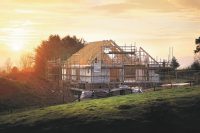The DIY VAT Scheme: A Guide to tax claims for private dwellings

28th January 2022
-
Ian Mullen See profile
Landowners who erect or convert buildings for residential or commercial use must be careful to reclaim the maximum amount of VAT back under the DIY VAT scheme. VAT claims for private dwellings can be made under the DIY VAT scheme, and while new dwellings are generally zero-rated, building contractors may charge the incorrect level of VAT, potentially invalidating a landowner’s claim.
Avoiding HMRC penalties
HM Revenue and Customs (HMRC) views DIY claims in the same way it views VAT returns – if you make a mistake or raise an erroneous claim you could face a financial penalty. And once a claim is rejected you cannot resubmit it, meaning you could lose tens of thousands of pounds.
Qualifying for DIY VAT – new builds
To qualify for the scheme, a new build must not be for business purposes, and must be classed under VAT law as a dwelling. Any labour must be zero-rated at source, as must any building materials provided and installed through the contractor. Any eligible materials bought separately will be charged at 20% VAT, which you can then reclaim.
Professional fees and equipment hire are not eligible for the scheme, nor are white goods – although fitted kitchen units do qualify.
Qualifying for DIY VAT – conversions
When it comes to eligible converted buildings, VAT should be charged at 5% by the contractor for the supply and installation of building materials (unless materials are purchased separately). The main area for concern is if the supplier charges the wrong amount – for example, 20% rather than 5% VAT – in which case HMRC will reject the DIY VAT claim.
DIY VAT scheme time limits
HMRC gives house builders and converters only three months to lodge a claim, but claims cannot be submitted until the building inspector has signed off the finished works, so timescales are tight. Additionally, HMRC may consider prior occupation of a self-build to constitute completion, meaning they may seek to treat a claim as out of time.
Landowners who are building or converting commercial buildings or properties for let will incur VAT at the usual 20%, and can claim that back through the business’ VAT registration. However, if you are renting the property out, you need to apply an option to tax the buildings and land, so that you can charge VAT on the rent and reclaim VAT on the building works.
"Making a mistake around value added tax (VAT) could lose you up to 100% of reclaimable tax"
Opting to tax means that you must minute your decision to tax, and then notify HMRC in writing of that decision within 30 days. Anyone buying a commercial building to let must also submit the option to tax paperwork if they want to charge and reclaim VAT.
You don’t need an option to tax if you sell a new commercial building within three years of completion or occupation (whichever happens first), as VAT is automatically chargeable to the buyer on the sale price. It’s also not required if the building is used for storage – this is automatically subject to VAT at 20%.
The key point here is that every situation is different, and the legislation is complex, so it’s vital to take specialist advice. Making a mistake around value added tax (VAT) could lose you up to 100% of reclaimable tax, so plan ahead and make sure everything is correct before proceeding with your project. It’s better to pay for professional advice now than to pay for mistakes later.


